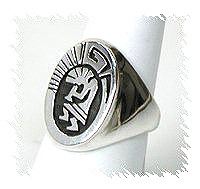The
kokopelli, flute player, often associated with the Hopi Flute Clan is the symbol
of happiness, joy and fertility. He is often a part of rituals related to marriage,
conception and birth and has been a part of the Ancient Pueblo Peoples since Hohokam
times (AD 750 – 850)
Usually depicted
as a non-gender figure, it was traditionally a male figure, often well endowed
until the missionaries discouraged such depiction !
©
2010 Horsekeeping ©
Copyright Information
The kokopelli
usually has feathers or a headdress protruding on the top of his head. His legs
are dancing in time to his own music.
Kokopelli
talks to the wind and the sky. His flute can be heard in the spring breeze, bringing
warmth after the winter cold. He is the symbolic seed bringer and water sprinkler.
His religious or supernatural power for fertility is meant to invoke rain as well
as impregnate women both physically and mentally. He is also associated with fertility
of wild animals.
The humbacked kokopelli
image is found from Casa Grande, Mexico to the Hopi and Rio Grande Pueblos and
then westward to the Californian deserts in prehistoric rock, effigy figures,
pottery, and on kiva walls.
Many tribes
embrace the kokopelli symbol. Here are some samples of its usage by Hopi, Zuni
and Navajo artists.

Hopi
Overlay Kokopelli Belt Buckle by Steven Sockyma

Navajo
Overlay Kokopelli Ring by Calvin Peterson

Navajo
Sterling Silver Kokopelli Pin Pendant by Robert Vandever

Navajo
Kokopelli Inlay Pendant

Zuni
Horse Fetish with Kokopelli petroglyphs by Tyrone Poncho

Hopi
Kokopelli Overlay Belt Buckle by Joe Josytewa
©
2010 Cherry Hill ©
Copyright Information
 Home
| Books | Articles |
Shopping | View
Cart | Contact | Site
Map | Search
Home
| Books | Articles |
Shopping | View
Cart | Contact | Site
Map | Search

